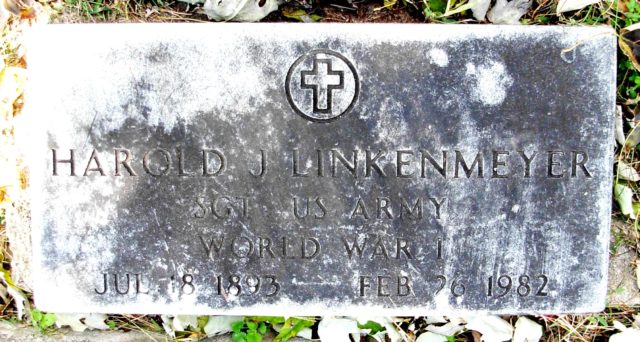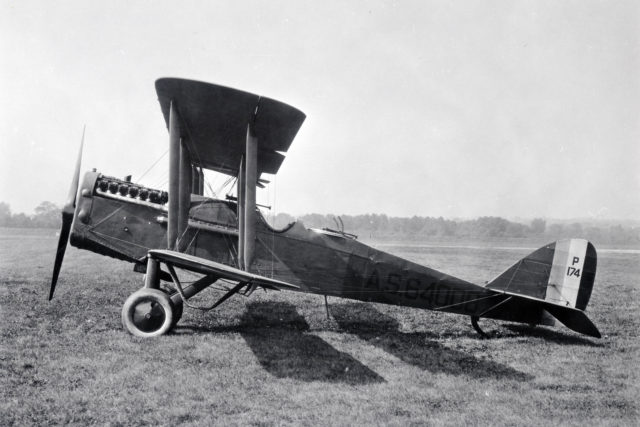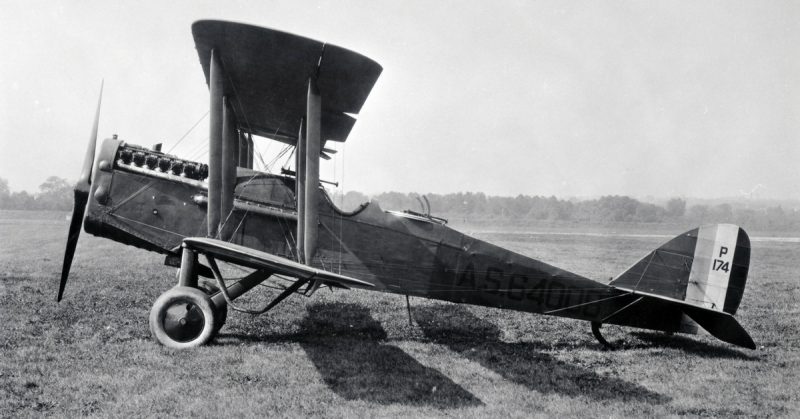War History online proudly presents this Guest Piece from Jeremy P. Ämick, who is a military historian and writes on behalf of the Silver Star Families of America.
The fence surrounding Woodland Cemetery-Old City Cemetery in Jefferson City, Mo., hems in hundreds of graves, many of those occupied by veterans of the nation’s wars, said Nancy Thompson, chairman of the Cemetery Resources Board of the City of Jefferson. But within the confines of this hallowed space lie the resting spots of only two known WWI veterans—one of whom served in the budding American Air Service, which years later morphed into the the U.S. Air Force.
Harold Linkenmeyer was born in Jefferson City on July 18, 1893, the son William Linkenmeyer, a German immigrant who later became chief engineer for the former G.H. Dulle Milling Company in Jefferson City.
In later years, when the younger Linkenmeyer came of age, he embarked upon his career by becoming a machinist for the former A. Priesmeyer Shoe Company in Jefferson City. This is where he was employed, his military service card indicates, when his draft lottery number was selected.
Inducted into the U.S. Army on September 20, 1917, the 24-year-old Linkenmeyer was assigned to Company M, 356th Infantry Regiment, which was “composed chiefly of men from Cole, Boone, Henry, Andrews, St. Louis and Jackson Counties” in Missouri, as was written in the official company history from World War I.
As the book goes on to explain, Linkenmeyer and his fellow recruits faced many challenges while stationed at Camp Funston, Kan., surviving “epidemics of Meningitis and other less serious diseases” in addition to overcoming a “shortage of clothing, equipment and facilities for training” during the early weeks of their initial training cycle.

But according to Linkenmeyer’s military service card, he did not become embroiled in the baptism of fire the 356th Infantry later endured in the trenches of France during the summer of 1918 since he was transferred to the 328th Aero Squadron in early January 1918—a component of the American Air Service.
Described as being “hardly out of its romper stage by April 1918,” wrote James Hudson in his book “Hostile Skies: The American Air Service in World War I,” the United States lacked not only “any tangible air strength,” but also “plans and programs for building an air service that could fight in Europe” at the outset of the war.
The book goes on to explain that the United States scrambled to prepare the American Air Service for the war by appropriating $64 million for the country’s military aviation program, “which was the largest sum ever appropriated by Congress for a single purpose up to that time.”
In “Order of Battle of the United States Land Forces in the World War” published by the Center of Military History for the U.S. Army, historians explained that it “was necessary to train a large body of mechanics to supply the ground force” for the aviators. Additionally, the book noted, instruction for enlisted mechanics grew to include the maintenance of machine guns, a speciality that paralleled much of Linkenmeyer’s experience as a machinist before the war.
Located at Kelley Field in San Antonio, Texas, the young man from Jefferson City remained with the squadron only five weeks before he was transferred to the aerial gunnery school at Ellington Field in Houston, Texas, the same location where an armorer’s school had been established only weeks earlier.
During the First World War, “observer/gunner positions were typically held by enlisted members…” wrote 2nd Lt. Chuck Widener in an article for the Air Force News Service. The author goes on to state, “Observers who sat in the rear cockpit of early World War I model warplanes, such as the De Havilland DH-4, quickly learned the advantages of a mounted machine gun” and soon began to claim victories while serving overseas.

Linkenmeyer continued his service at Ellington Field until May 17, 1918, at which time he was transferred to the Camp John Dick Aviation Concentration Camp in Dallas, Texas. According to the website of the Texas State Historical Association, during World War I, the camp became “a personnel holding pool for graduates of ground training schools” until they were assigned to an aviation training field.
The Jefferson Citian remained at Camp Dick through the signing of the armistice on November 11, 1918. Several weeks after the war ended, on January 6, 1919, Linkenmeyer, was transferred to 676th Aero Squadron, whose headquarters was located on Camp John Dick. Linkenmeyer was promoted to the rank of sergeant on January 10, 1919 and, two months later, was honorably discharged from the Army.
In the years after the war, Linkenmeyer remained in Mid-Missouri and worked many years for the former Tweedie Footwear Corporation in Jefferson City. The veteran passed away on February 1, 1982, never marrying or with any children to pass down his story of service in the burgeoing American Air Service.
When reflecting on his service in his golden years, one can only imagine the words Linkenmyer would have used to describe his time with the Air Service during the war. Though it is a great unknown, perhaps his description would have closely paralleled the statement made by General Douglas MacArthur in 1951.
“And like the old soldier of that ballad, I now close my military career and just fade away—an old soldier,” MacArthur said, “who tried to do his duty as God gave him the light to see that duty.”
